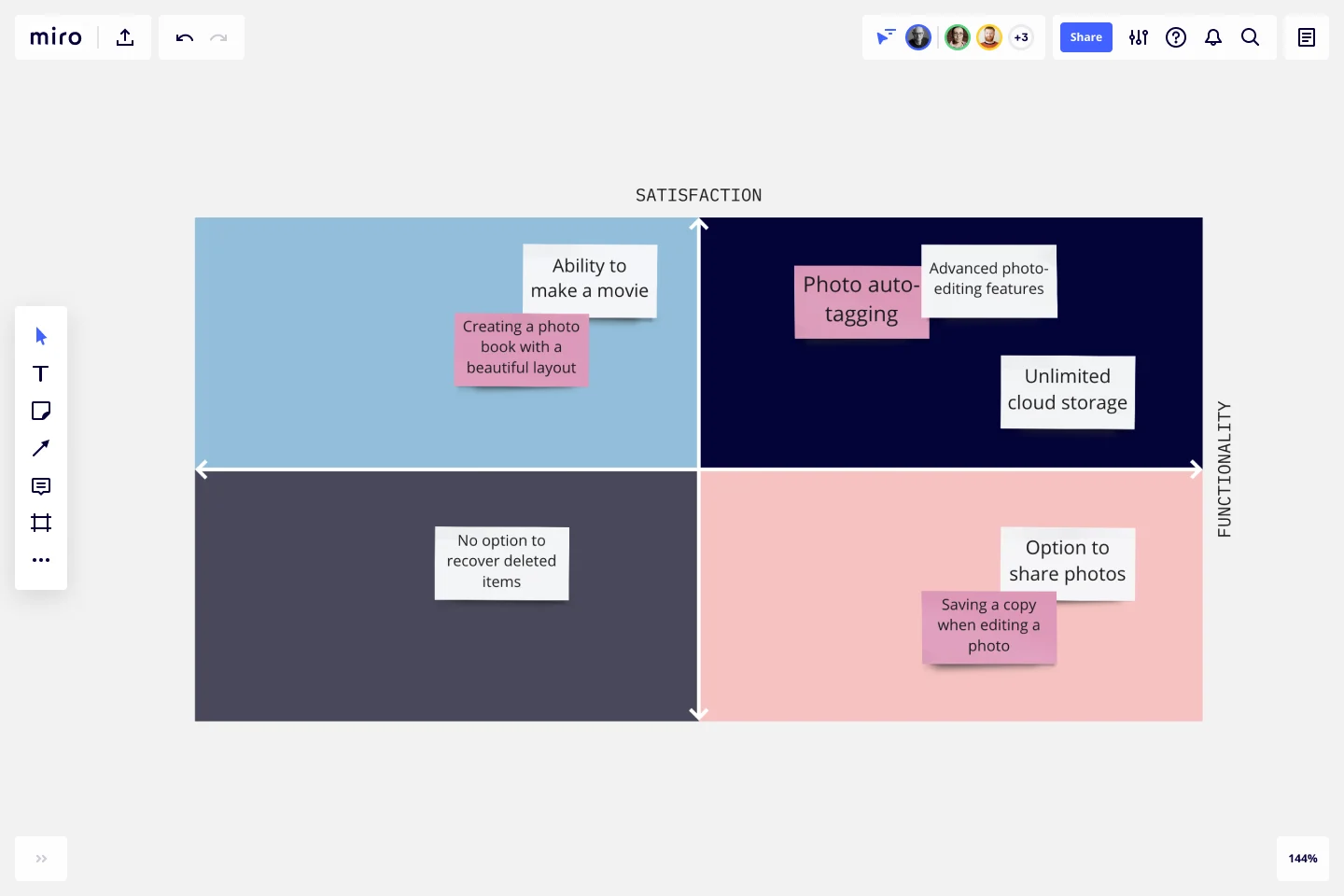Kano Model Template
Kano Analysis is a powerful tool where you can map which product attributes which are perceived to be important to customers. Ideal for product development and customer satisfaction.
About the Kano model template
What is the Kano model?
The Kano model is a method for prioritizing features on a product roadmap. Prioritization is assigned based on the likelihood that a given feature will satisfy your customers. Product teams can use the Kano model to weigh a high-satisfaction feature against the costs of implementation, making it easier to decide whether they should add this feature to the roadmap. Many product managers prioritize features by grouping them into categories based on whether they are likely to disappoint, satisfy, or delight customers.
How does the Kano model work?
The Kano model uses two axes: satisfaction and functionality. The axes create a quadrant with four values: attractive, performance, indifferent, and must-be. Teams can use this model to understand, prioritize, and integrate the main categories of customer requirements into the products they develop. When teams understand which requirements are most valuable to customers, they can plan and use resources wisely.
What are the four categories in the Kano model?
The Kano model classifies features into four categories based on how customers might react to them.
Performance: These features directly impact whether the product is good at performing its intended function. Put another way: the more of this feature you receive, the greater your satisfaction will be. Gas mileage is the most common example. When you’re buying a car, you treat gas mileage as a Performance attribute.
Must-be: Customers expect these features. If your product doesn’t have one, then your customers will consider your project bad or incomplete. For example, you expect your car to have brakes. If it doesn’t have brakes, you’re not buying it.
Attractive: Although these features aren’t strictly necessary, they cause a positive reaction. A leather interior doesn’t make a car work any better, but it’s nice to have and increases the value of the car.
Indifferent: The presence or absence of this feature does not impact you in any way. Organizations typically avoid working on features that fall into this category because they are a waste of resources.
Create your own
Now that you know how to create your own Kano model, get started with this free template. It’s easy to create and share it with your teammates.
Get started with this template right now.
Taco Tuesday Retrospective
Works best for:
Agile Methodology, Retrospectives, Meetings
The Taco Tuesday Retrospective template offers a fun and informal approach to retrospectives, perfect for fostering team camaraderie. It provides elements for reflecting on past iterations over a casual taco-themed gathering. This template enables teams to relax, share insights, and brainstorm ideas in a laid-back atmosphere. By promoting social interaction and creativity, the Taco Tuesday Retrospective empowers teams to strengthen relationships, boost morale, and drive continuous improvement effectively.
Empathy Map by Aremu Dominion
Works best for:
Product Management
Improve your understanding of customer needs with the Empathy Map by Aremu Dominion. This template allows you to capture and analyze your audience's emotions, thoughts, and experiences. Use it to create user-centered products and services that resonate with your customers. Perfect for design thinking workshops, product development, and marketing teams focused on empathy-driven innovation.
Azure Architecture Diagram Template
Works best for:
Software Development, Diagrams
The Azure Architecture Diagram Template is a diagram that will help you visualize the combination of any data and build and deploy custom machine learning models at scale. Azure is Microsoft’s cloud computing platform, designed to provide cloud-based services such as remote storage, database hosting, and centralized account management. Use Azure Architecture Diagram template to build sophisticated, transformational apps.
Kaizen Report Template
Works best for:
Agile Methodology, Operations, Documentation
What makes a great company great? They know that greatness needs to be fostered and maintained — meaning they never stop working to improve. If you’re one of those companies (or aspire to be), a kaizen report is an ideal tool. It creates a simple visual guide to continuous improvement activities on a team, departmental, and organizational level. Using a kaizen report approach, every employee in an organization audits their own processes and understands what they might have overlooked, making this a powerful tool for increasing accountability at all levels.
Blue Ocean 4 Actions Framework Template
Works best for:
Leadership, Decision Making, Strategic Planning
For entrepreneurs, so much comes down to new users—how to attract them, impress them, and convert them to loyal customers. This template, designed by the authors of Blue Ocean Strategy: How to Create Uncontested Market Space and Make the Competition Irrelevant, will help you maximize value for you and your customers alike. Using the template’s four steps (divided into easy columns), you’ll easily evaluate your products in more innovative ways and make sure money is being spent in areas that really matter.
Product Positioning Canvas
Works best for:
Product Management, Planning
The Product Positioning Canvas template aids product managers in defining and communicating product positioning strategies. By analyzing target markets, competitive landscapes, and unique value propositions, this template helps differentiate products in the market. With sections for defining brand attributes, messaging, and market segments, it enables teams to craft compelling positioning statements that resonate with target audiences. This template serves as a guide for aligning product positioning with business objectives and driving market success.
